Excavation Contractors North Riverside
Find Excavating Contractor in North Riverside
Receive 3 FREE Excavation Contractors Near Me quotes for your project today! Compare profiles, reviews, accreditations, portfolio, etc... and choose the best deal.
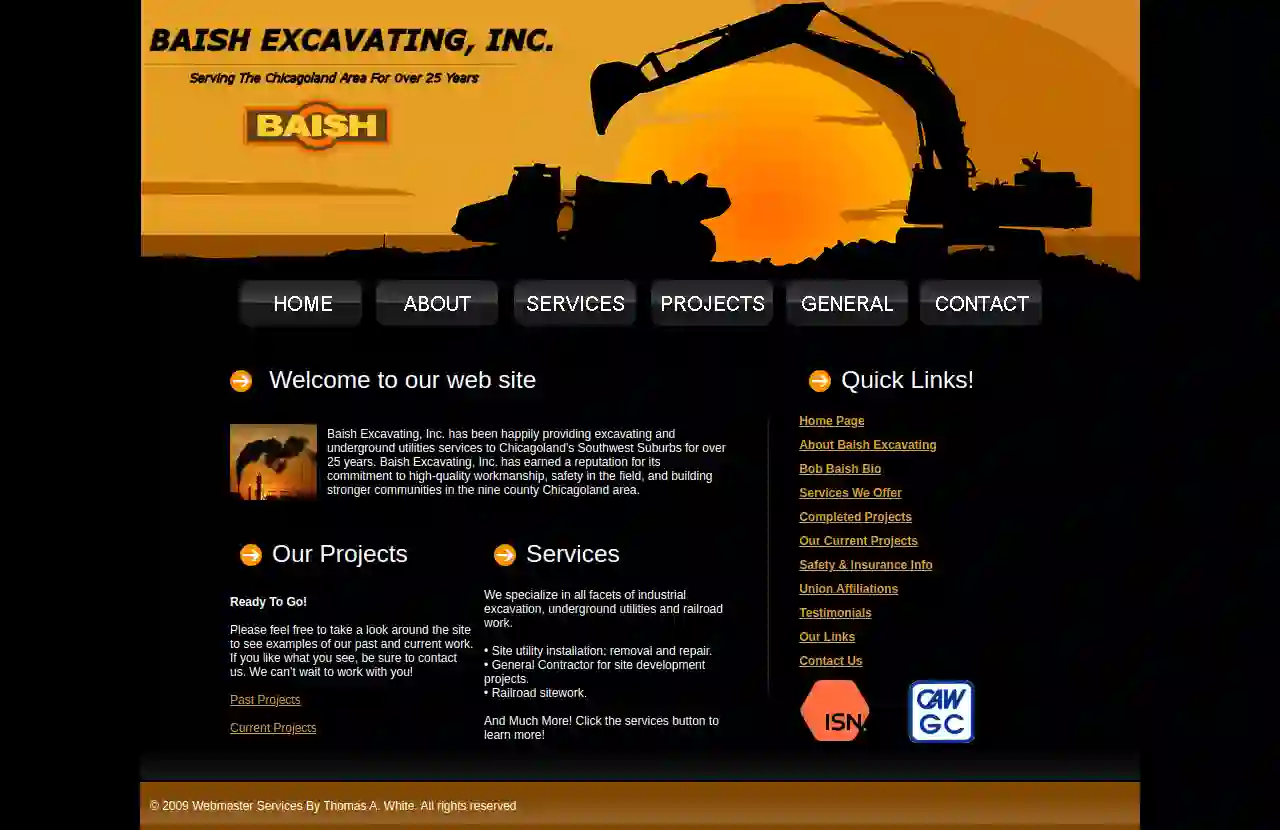
Baish Excavating, Inc.
3485-B Rt 126, Oswego, 60543, USBaish Excavating: Building Stronger Communities For over 30 years, Baish Excavating, Inc. has been a trusted name in Will County, Grundy County, and surrounding communities. A member of the Contractor's Association of Will and Grundy Counties since 1991, Baish Excavating, Inc. contributes to projects that build businesses, renovate the land and benefit the local economy. In 1985, Bob Baish founded Baish Excavating because he saw the need for high-quality excavating and underground utilities services in his community � an area that had the potential for immense residential and industrial growth. With that vision in mind, he rented a shop on Plainfield-Naperville Road in Plainfield, Illinois with a modest crew of three men (one of which was Bob�s dad, Art) and four machines. Today, the shop has upgraded in size and houses 35 pieces of machinery. The crew and staff has expanded along with the size of the workload, but the same old work ethic applies: Baish Excavating, Inc. is committed to building stronger local communities, one job at a time.
- Services
- Why Us?
- Our Team
- Testimonials
- Gallery
Get Quote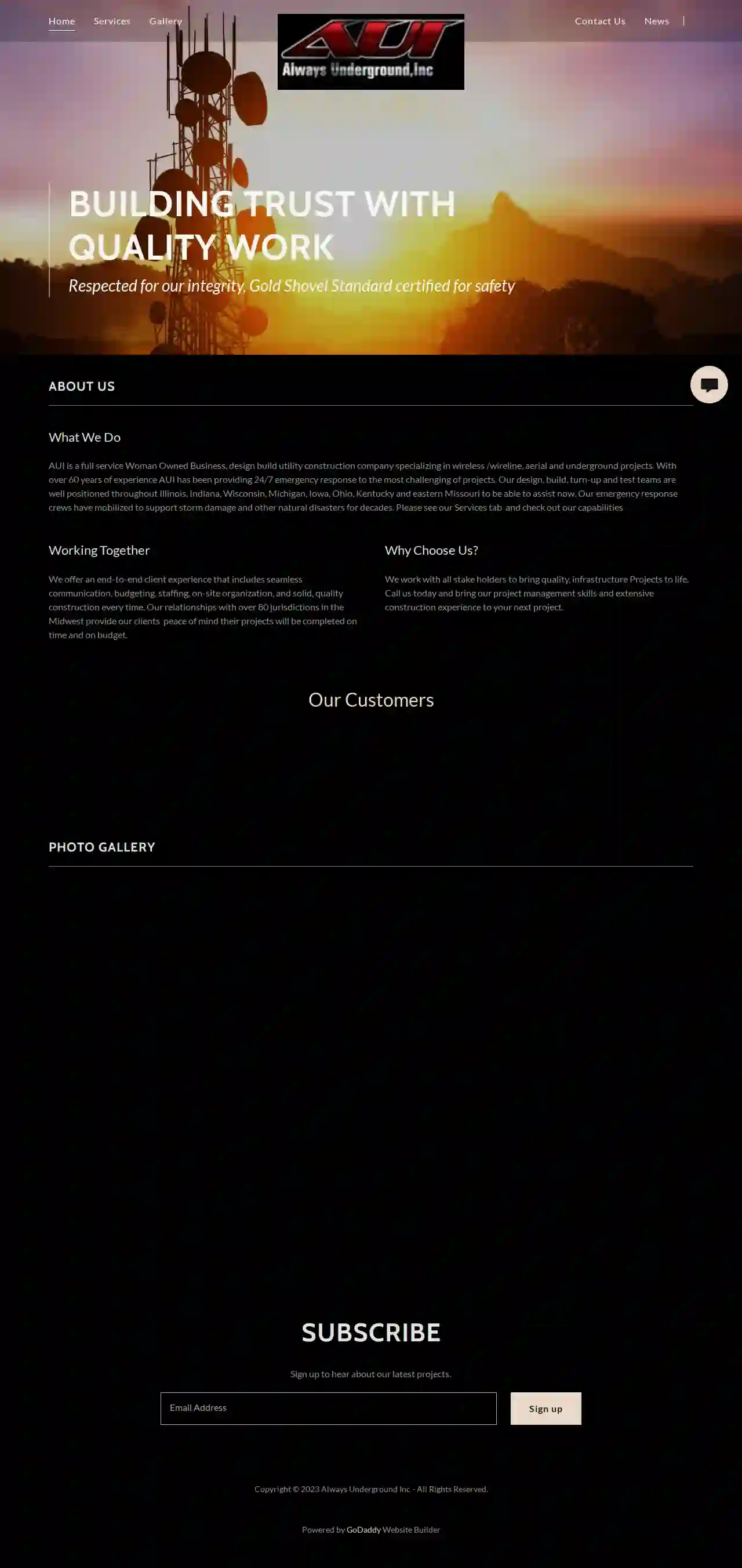
Always Underground Inc
3.316 reviews20603 Burl Court, 20603 Burl Ct, Joliet, 60433, USBuilding Trust with Quality Work Respected for our integrity, Gold Shovel Standard certified for safety About Us AUI is a full service Woman Owned Business, design build utility construction company specializing in wireless /wireline, aerial and underground projects. With over 60 years of experience AUI has been providing 24/7 emergency response to the most challenging of projects. Our design, build, turn-up and test teams are well positioned throughout Illinois, Indiana, Wisconsin, Michigan, Iowa, Ohio, Kentucky and eastern Missouri to be able to assist now. Our emergency response crews have mobilized to support storm damage and other natural disasters for decades. Please see our Services tab and check out our capabilities Working Together We offer an end-to-end client experience that includes seamless communication, budgeting, staffing, on-site organization, and solid, quality construction every time. Our relationships with over 80 jurisdictions in the Midwest provide our clients peace of mind their projects will be completed on time and on budget. Why Choose Us? We work with all stake holders to bring quality, infrastructure Projects to life. Call us today and bring our project management skills and extensive construction experience to your next project.
- Services
- Why Us?
- Gallery
Get Quote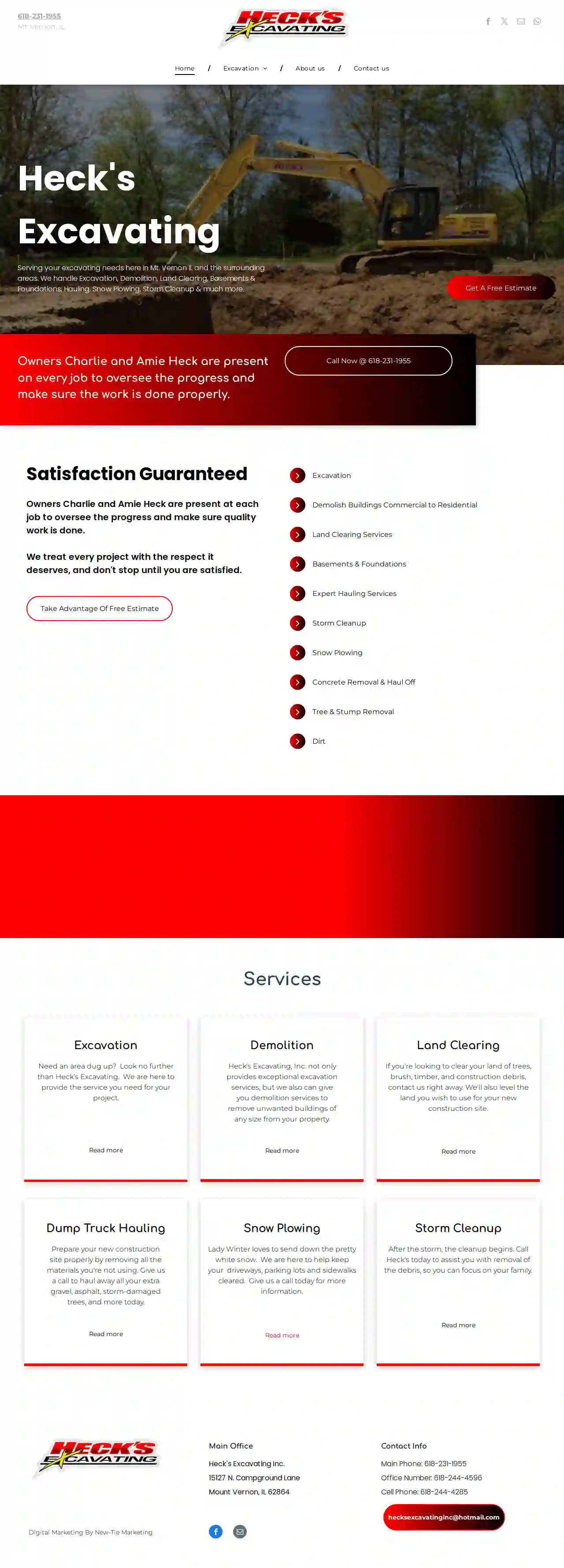
Heck’s Excavating
15127 N. Campground Lane, Mount Vernon, 62864, USHeck's Excavating: Your Trusted Partner for Excavation and More Heck's Excavating Inc. has been serving the Mt. Vernon, IL area and surrounding communities since 2009. We are a family-owned business dedicated to providing high-quality excavation, demolition, and other services with a commitment to customer satisfaction. Our Commitment to Quality Owners Charlie and Amie Heck are personally involved in every project, ensuring that every job is completed to the highest standards. We believe in treating every project with the respect it deserves, and we don't stop until you are completely satisfied. A Wide Range of Services From excavation and demolition to land clearing, basement and foundation work, hauling, snow plowing, and storm cleanup, Heck's Excavating is your one-stop shop for all your project needs. We are equipped to handle projects of all sizes, both residential and commercial. Experience the Heck's Difference We take pride in our work and treat every job as if it were our own home or office. Our commitment to quality, service, and customer satisfaction sets us apart. Choose Heck's Excavating for a reliable and trustworthy partner for your next project.
- Services
- Why Us?
- Our Team
- Gallery
Get Quote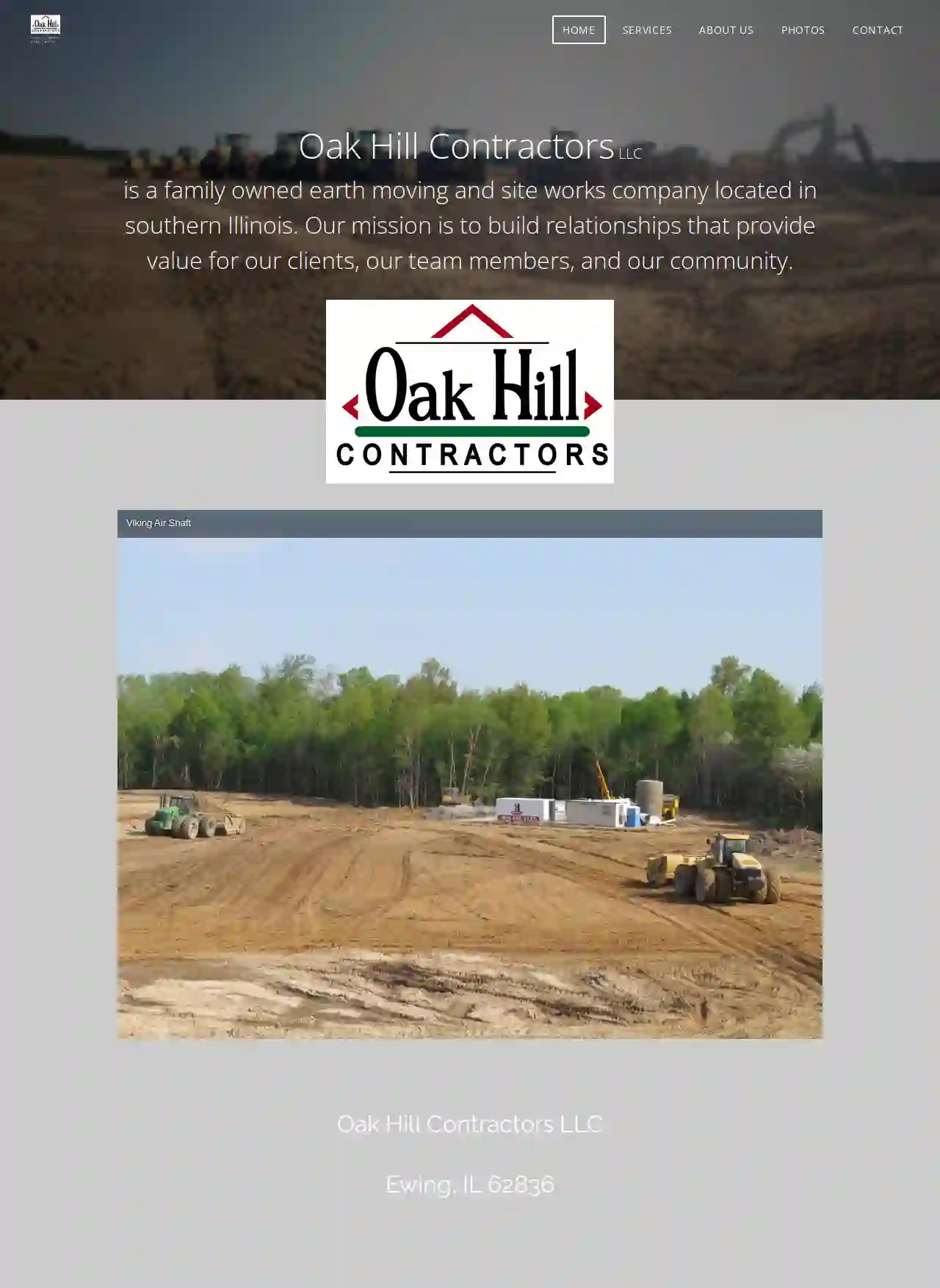
Oak Hill Contractors LLC
53 reviews20245 Ewing Road, Ewing, 62836, USAbout Oak Hill Contractors LLC Oak Hill Contractors LLC is a family-owned earth moving and site works company based in southern Illinois. We are dedicated to building strong relationships with our clients, team members, and the community, ensuring value for everyone involved. Our commitment to quality work and a wide range of equipment allows us to handle projects of all sizes. We utilize GPS-equipped machines for efficient and accurate grading work, ensuring precision and timely completion. We are proud to be Prequalified by IDOT and have MSHA-trained personnel. We are also fully insured, providing peace of mind to our clients. Take a look at one of our recent projects: Sugar Camp Refuse Expansion.
- Services
- Why Us?
- Gallery
Get Quote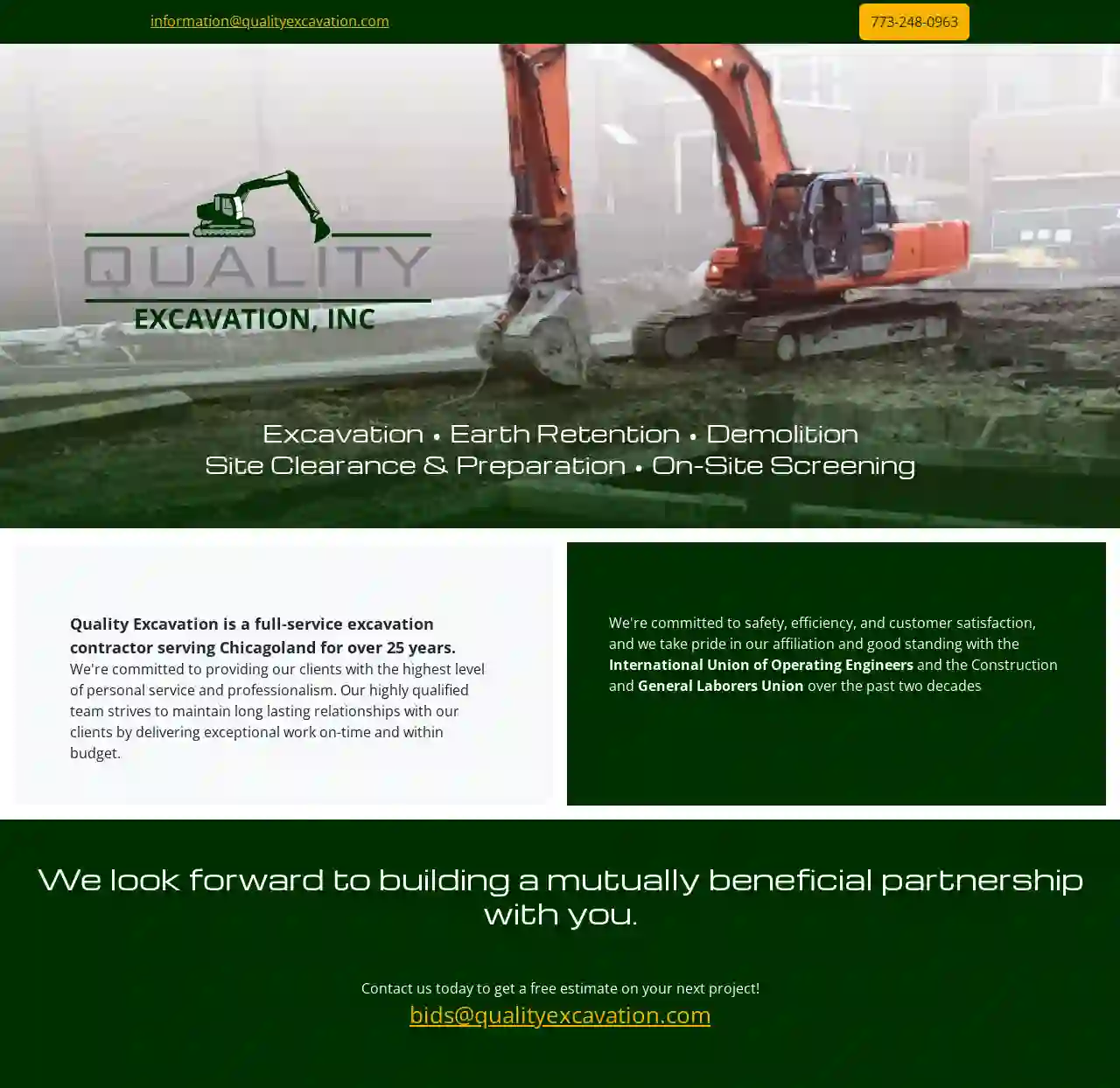
Quality Excavation Inc
54 reviewsChicago, USQuality Excavation: Your Trusted Chicagoland Excavation Partner Quality Excavation is a full-service excavation contractor serving Chicagoland for over 25 years. We're dedicated to providing our clients with the highest level of personalized service and professionalism. Our highly skilled team is committed to building lasting relationships by delivering exceptional work on time and within budget. We prioritize safety, efficiency, and customer satisfaction. We're proud of our strong affiliations and good standing with the International Union of Operating Engineers and the Construction and General Laborers Union over the past two decades. We look forward to building a mutually beneficial partnership with you. Contact us today for a free estimate on your next project!
- Services
- Why Us?
Get Quote
BMB Excavation LLC
44 reviewsNorthwood, USBMB Excavation LLC BMB Excavation LLC is a fully insured, professional company with years of experience, located in Northwood NH. We specialize in a wide variety of services in residential and commercial work, such as septic system, foundation, sewer, water, drains, utilities, and excavation. We work hard with homeowners and contractors to meet deadlines on all projects and tasks, we strive on getting passed challenging obstacles to insure the same vision or goals. Our mission is to provide quality service to customers and contractors and build professional relationship to obtain same vision, plan, and goal.
- Services
- Why Us?
- Testimonials
- Gallery
Get Quote
John Keno & Co
4.19 reviews8623 W Bryn Mawr Ave., Chicago, 60631, USJKC Overview Since 1946, John Keno & Company has provided world-class site preparation, excavating and shoreline development services throughout Chicagoland and along the shores of Lake Michigan. We are a third-generation, veteran-owned company with a deep commitment to safety, quality, and customer satisfaction. Our team of experienced professionals is dedicated to providing our clients with the highest level of service and expertise. Our Values Our values are the foundation of our success. We are committed to: World-class performance Serving as an excavation extension of your team Harnessing new technology to solve more problems
- Services
- Why Us?
- Gallery
Get Quote
F.L. Merrill Construction, Inc.
51 reviews35 Veterans Drive, Loudon, 03275, USProudly Serving New Hampshire Since 1990. Located In Loudon, NH Family Owned & Operated NH Construction Company Get A Quote Municipal Construction We specialize in road construction for small local subdivisions. Our expertise includes building, constructing, & repairing roadways. Commercial Construction Our New Hampshire commercial construction experience includes land clearing, site work, utility installation, and more. Residential Construction Whether you need help with excavation for a new septic system or any other excavation need, our team has 25+ years of experience. Who We Are A Dedicated Team Of Construction Experts F.L. Merrill Construction's success is built on a foundation of hard work and dedication, values that are shared by everyone from upper management to construction crew members. Frank and Sue Merrill realized their ability to provide customers with a superior service comes down to their team who are consider to be an extension of their family. By investing in its people, Merrill Construction has established itself as a NH construction industry leader for over three decades. Tell us about your project! Land Clearing Site Work Utility Installation Road Construction Bridge Construction Footing Foundations Residential Excavation Materials Supply Trucking & Dumping Get A Free Quote Today! Get A Quote
- Services
- Why Us?
- Testimonials
- Gallery
Get Quote
K B Earthworks
54 reviewsGilmanton, USKB Earthworks: Your Trusted Partner for Excavation, Trucking, and Site Clearing in Central New Hampshire KB Earthworks is a locally owned and operated business serving the Lakes Region in Central New Hampshire. We're passionate about providing top-notch excavation, trucking, and site clearing services to both residential and commercial clients. With a wide range of heavy equipment and over 30 years of combined experience, we're equipped to handle projects of all sizes, from small-scale landscaping to large-scale land development. Our team is dedicated to delivering exceptional service, exceeding expectations, and ensuring customer satisfaction. We pride ourselves on our commitment to safety, quality, and efficiency. We work closely with our clients to understand their needs and provide customized solutions that meet their specific requirements. Whether you're looking to create a new driveway, clear land for a new construction project, or install a septic system, KB Earthworks is your one-stop shop for all your sitework needs. We're committed to providing our clients with the highest quality workmanship and exceptional customer service. Contact us today for a free consultation and estimate.
- Services
- Why Us?
- Testimonials
- Gallery
Get Quote
Summit Stoneworks - Hardscaping & Excavation Services
513 reviews356 Davison Rd, Henniker, 03242, USFrom Vision to Reality Hi! My name is Rob Leite, and I am the Proud Owner and Operator of Summit Stoneworks. Nestled in the picturesque town of Henniker, New Hampshire, Summit Stoneworks is dedicated to delivering exceptional site preparation and hardscaping services. Our company prides itself on transforming your property to unlock its full potential for various construction and development projects. Comprehensive Services for Maximum Impact At Summit Stoneworks, we understand the pivotal role of thorough site preparation. Our suite of services is designed to enhance the usability, value, and safety of your land, providing significant benefits to your projects: Maximizing Usable Space Our comprehensive land clearing services, including stump removal, convert overgrown and underutilized areas into prime land ready for construction, landscaping, or agricultural expansion. Enhancing Property Value A clean, well-maintained property not only looks appealing but also carries a higher market value. Our expert services significantly boost the aesthetic and market appeal of your property, attracting potential buyers or investors. Gravel Driveways As part of our commitment to enhancing your property, Summit Stoneworks offers gravel driveway installation, combining functionality with aesthetic appeal: Cost-Effective and Easy Installation: Gravel driveways are economical and can be quickly installed, offering an immediate, functional upgrade to your property. Superior Drainage and Customizable Design: A gravel driveway prevents water accumulation and flooding with its excellent drainage capabilities. Available in various colors and sizes, it can be tailored to complement the aesthetic of your landscape. Durability and Low Maintenance: Gravel is durable and withstands heavy use without the need for frequent repairs. It’s easy to maintain and provides natural weed prevention, keeping your driveway looking neat with minimal effort. Enhanced Traction: Especially beneficial in winter, gravel driveways offer better traction than paved surfaces, reducing the risk of slips and falls. Why Choose Summit Stoneworks? Commitment to Reliability and Timeliness: We value meeting our clients' deadlines and budgetary constraints, ensuring that every project is delivered on time without compromising on quality. Exceptional Quality and Results: Our unwavering pursuit of excellence guarantees outcomes that exceed your expectations, solidifying our reputation as leaders in the field. Partner with Summit Stoneworks to experience how we can make a significant difference in preparing and enhancing your property. Contact us today for a free consultation and let us help you unlock the full potential of your land!
- Services
- Why Us?
- Our Team
- Testimonials
- Gallery
Get Quote
Over 22,076+ Excavation Companies on our platform
Our excavation providers operate in North Riverside and beyond!
ExcavationHQ has curated and vetted Top Excavation Businesses near North Riverside. Find a trustworthy business today.
Frequently Asked Questions About Excavation Contractors
- New Construction: Laying foundations, basements, or underground utilities for new buildings.
- Home Additions: Creating space for new rooms, basements, or extensions.
- Landscaping: Leveling ground, creating slopes, installing retaining walls, or digging for ponds or pools.
- Drainage Improvement: Installing French drains, drainage ditches, or swales to manage water runoff.
- Utility Installation or Repair: Laying new water, sewer, gas, or electrical lines, or repairing existing ones.
- Demolition: Clearing debris and preparing the site after demolishing a structure.
- Clear the Area: Remove any obstacles, including vehicles, outdoor furniture, landscaping features, or structures, from the excavation zone and surrounding area.
- Mark Existing Features: Identify and mark underground utilities, septic tanks, sprinkler systems, or other buried elements you want to protect.
- Protect Landscaping: Use tarps or fencing to shield trees, shrubs, gardens, or other landscaping elements from damage.
- Provide Access: Ensure the excavation contractor has clear access to the work area, including gates wide enough for equipment.
- Discuss Logistics: Coordinate with the contractor regarding parking arrangements, material delivery, and any special instructions or concerns you might have.
- Determine the Area: Measure the length and width of the area you want to fill. Multiply them to get the area in square feet (or meters).
- Determine the Depth: Measure the difference between the existing grade and the desired grade (how much you need to raise the ground). This is the depth of fill required.
- Calculate Volume: Multiply the area (step 1) by the depth (step 2) to get the volume in cubic feet (or meters).
- Account for Compaction: Fill dirt compacts when it settles, so add 10% to 25% to the calculated volume to account for compaction. The exact percentage depends on the type of fill material.
- Project Size and Scope: The larger and more complex the excavation, the higher the cost.
- Soil Type: Different soil types require different equipment and techniques, impacting costs. Rocky or clay-rich soil can be more expensive to excavate than loose soil.
- Accessibility: Difficult-to-access sites might require specialized equipment or additional labor, increasing expenses.
- Disposal Costs: Hauling away excavated material (soil, rocks, etc.) to disposal sites incurs additional fees.
- Permits and Inspections: Depending on local regulations, permits and inspections might be required, adding to the overall cost.
How do I know if I need excavation for my project?
How do I prepare my property for excavation?
How do I calculate how much dirt I need for fill?
How much does excavation cost?
How do I know if I need excavation for my project?
- New Construction: Laying foundations, basements, or underground utilities for new buildings.
- Home Additions: Creating space for new rooms, basements, or extensions.
- Landscaping: Leveling ground, creating slopes, installing retaining walls, or digging for ponds or pools.
- Drainage Improvement: Installing French drains, drainage ditches, or swales to manage water runoff.
- Utility Installation or Repair: Laying new water, sewer, gas, or electrical lines, or repairing existing ones.
- Demolition: Clearing debris and preparing the site after demolishing a structure.
How do I prepare my property for excavation?
- Clear the Area: Remove any obstacles, including vehicles, outdoor furniture, landscaping features, or structures, from the excavation zone and surrounding area.
- Mark Existing Features: Identify and mark underground utilities, septic tanks, sprinkler systems, or other buried elements you want to protect.
- Protect Landscaping: Use tarps or fencing to shield trees, shrubs, gardens, or other landscaping elements from damage.
- Provide Access: Ensure the excavation contractor has clear access to the work area, including gates wide enough for equipment.
- Discuss Logistics: Coordinate with the contractor regarding parking arrangements, material delivery, and any special instructions or concerns you might have.
How do I calculate how much dirt I need for fill?
- Determine the Area: Measure the length and width of the area you want to fill. Multiply them to get the area in square feet (or meters).
- Determine the Depth: Measure the difference between the existing grade and the desired grade (how much you need to raise the ground). This is the depth of fill required.
- Calculate Volume: Multiply the area (step 1) by the depth (step 2) to get the volume in cubic feet (or meters).
- Account for Compaction: Fill dirt compacts when it settles, so add 10% to 25% to the calculated volume to account for compaction. The exact percentage depends on the type of fill material.
How much does excavation cost?
- Project Size and Scope: The larger and more complex the excavation, the higher the cost.
- Soil Type: Different soil types require different equipment and techniques, impacting costs. Rocky or clay-rich soil can be more expensive to excavate than loose soil.
- Accessibility: Difficult-to-access sites might require specialized equipment or additional labor, increasing expenses.
- Disposal Costs: Hauling away excavated material (soil, rocks, etc.) to disposal sites incurs additional fees.
- Permits and Inspections: Depending on local regulations, permits and inspections might be required, adding to the overall cost.